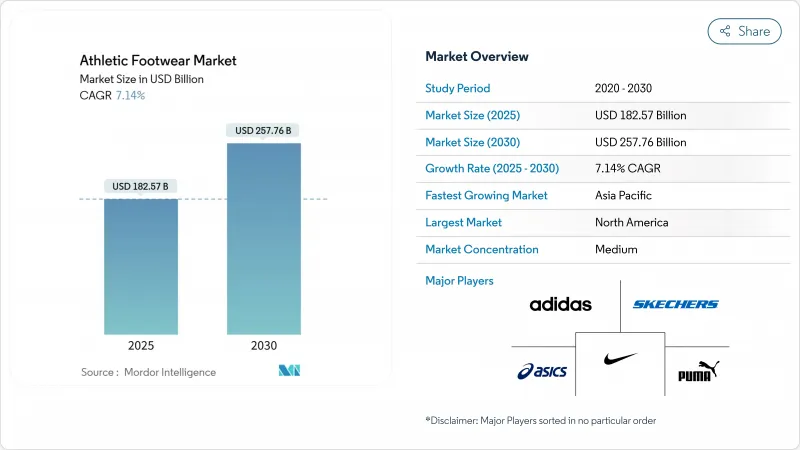
|
市場調査レポート
商品コード
1852069
アスレチックフットウェア:市場シェア分析、産業動向、統計、成長予測(2025年~2030年)Athletic Footwear - Market Share Analysis, Industry Trends & Statistics, Growth Forecasts (2025 - 2030) |
||||||
カスタマイズ可能
適宜更新あり
|
|||||||
| アスレチックフットウェア:市場シェア分析、産業動向、統計、成長予測(2025年~2030年) |
|
出版日: 2025年08月18日
発行: Mordor Intelligence
ページ情報: 英文 120 Pages
納期: 2~3営業日
|
概要
アスレチックフットウェアの市場規模は2025年に1,825億7,000万米ドルと推定され、2030年には2,577億6,000万米ドルに達すると予測され、CAGRは7.14%で推移します。

パフォーマンス・シューズとライフスタイル・シューズの需要は引き続き旺盛で、組織化されたスポーツに参加する女性が増えているため、アスレチック・ウェアとカジュアル・ウェアの境界線はますます曖昧になっています。この動向がアスレチックフットウェア市場のビジネスチャンスを拡大しています。各ブランドは現在、女性のバイオメカニクスに合わせた製品を発表し、パフォーマンスと快適性を高めるために、高度なクッショニングやプレート技術をランニングモデルに組み込んでいます。また、デジタルDTC(Direct-to-Consumer)プラットフォームも強化されており、エンゲージメントを高めるだけでなく、仲介業者への依存を減らすことで利益率も改善しています。さらに、ブランドはデータ分析を活用して顧客体験をパーソナライズし、商品提供を最適化しています。さらに、アスレチックフットウェア市場は、専門小売業者のチャネル統合、eコマースへの迅速なシフト、スポーツインフラへの政府投資の増加により、先進国と新興国の両方で成長を遂げています。また、持続可能性や環境に優しい素材への注目が高まっていることも、同市場の製品革新や消費者の嗜好に影響を与えています。
世界のアスレチックフットウェア市場の動向と洞察
女性のスポーツ参加率の大幅な伸び
女性のスポーツ参加の増加は、アスレチックフットウェア市場に変革をもたらし、ブランドは進化する消費者の嗜好に対応するために製品ポートフォリオを適応させる必要に迫られています。2024年のWomen's Sports Foundationのレポートによると、調査対象となった女性の67%が、スポーツに参加することでリーダーシップスキルが身についたと回答しており、この動向が社会により大きな影響を与えることを強調しています。ムーラ・キックス(Moolah Kicks)のような女性バスケットボール選手専用の新興企業は、この市場の可能性を例証しています。同社は、4年間で150%という驚異的な売上成長を達成し、小売店舗を140店舗から630店舗に拡大した。それに応えるように、既存ブランドは、ラスト、クッション密度、トラクションパターンの調整など、女性のバイオメカニクスに合わせた製品をデザインすることで革新を図っています。さらに、著名な女性アスリートとコラボレートして、女性消費者の共感を呼ぶスタイル主導のカラーリングを発売しています。このシフトは、より大きな包摂性を育み、より高い参入率を促し、歴史的に男性優位であったアスレチックフットウェア市場を大幅に拡大しています。女性のニーズに焦点を当てた進化は、製品イノベーションを再構築するだけでなく、市場力学を再定義し、新興企業にも既存企業にも新たな成長機会を生み出しています。
有名ブランドによる積極的なマーケティング
アスレチックフットウェア市場は、世界的な大手企業が広告戦略を強化し、市場シェアを確保・拡大するために高度な視聴者マイクロセグメンテーション技術を採用することで、急速な変貌を遂げつつあります。世界市場シェアの約18%を占めるナイキは、今後10年間で年平均5%の収益成長を達成するという目標を掲げています。この成長の大部分は大中華圏からもたらされる見込みで、同社は11%の成長率を目標としています。この地域は、加速する都市化、中間層の拡大、可処分所得の増加により、高品質なアスレチックフットウェアへの需要が高まっており、大きなビジネスチャンスをもたらしています。同時に、アディダスは、競合の弱点を活用し、棚でのプレゼンス強化と市場への浸透を促進するため、戦略的に米国のチャネルにメディア予算を振り向けています。両社とも、データ主導のパーソナライゼーションとオムニチャネル統合に多額の投資を行っており、顧客エンゲージメントの強化、コンバージョン率の向上、販売プロセスの迅速化を実現しています。加えて、eコマース・プラットフォームの導入が進み、アスレジャーの動向が高まっていることも、市場の拡大にさらに寄与しています。こうした戦略的イニシアティブは、消費者の嗜好の進化や技術の進歩と相まって、アスレチックフットウェア市場の持続的成長と競争激化の原動力となっています。
偽造品の拡散
模倣品は依然として重大な課題であり、アスレチックフットウェア市場において消費者の信頼を損ない、大きな収益損失をもたらしています。OECDのレポートによると、2025年に押収された税関の21.4%が偽造靴であり、中国、トルコ、香港が偽造品の一次情報源となっています。欧州連合(EU)は模倣品の重要な輸出先となっており、この問題の世界的な規模を浮き彫りにしています。さらに、米国通商代表部は2025年特別301号報告書の中で、知的財産(IP)集約型部門が経済成長の原動力として極めて重要な役割を担っていることを強調するとともに、模倣品がマクロ経済に及ぼす影響の大きさを強調しています。この問題に対処するため、ブランドはRFID認証、ブロックチェーン・ベースの追跡システム、フォレンジック・ラベリングといった高度な偽造防止技術の採用を増やしています。これらのソリューションは製品のセキュリティとトレーサビリティを強化するが、運用コストの増大も招きます。その結果、企業は利益率を圧迫しかねないこれらのコストを吸収するか、価格上昇を通じて消費者に転嫁するかという課題に直面し、市場に複雑なトレードオフを生み出しています。
セグメント分析
2024年には、スポーツシューズがアスレチックフットウェア市場の46.89%を占め、チームスポーツでの汎用性とアスレジャーの動向の高まりがその原動力となりました。この優位性は、パフォーマンスとライフスタイルの両方のニーズに応える二重機能性に起因します。ナイキは、2024年度のフットウェア売上高を334億米ドルと発表しました。このセグメントは、普段履きとしてパフォーマンスシルエットの採用が増加していることから、引き続き利益を得ています。さらに、多様なカラーリングの導入やアスリート、デザイナー、インフルエンサーとの戦略的コラボレーションにより、スポーツシューズはファッションの定番へと昇華し、性別、年齢層、地域を問わず持続的な需要を確保しています。
ランニングシューズは、2025年から2030年にかけてCAGR 7.35%の力強い成長を遂げ、アスレチックフットウェア市場全体を上回ると予測されます。この成長の原動力となっているのは、デザインと素材における絶え間ない革新であり、各ブランドはカーボンファイバー・プレート、オーバーサイズ・ミッドソール、アダプティブ・メッシュ・アッパーといった先進機能を取り入れて、エネルギー・リターンの強化、快適性の向上、怪我のリスクの低減を図っています。ペガサス・プレミアム、アディゼロ・ボストン13、ハイペリオン・エリート3などの主力製品の発売は、スタック高40mmを超える軽量フォームへのシフトを強調し、エリートアスリートとレクリエーショナルランナーの両方にアピールしています。さらに、新モデルの30%以上がリサイクル素材を採用しており、このセグメントは、持続可能性に対する消費者の需要の高まりに合致しています。こうした性能、革新性、環境に対する責任の組み合わせは、このセグメントのアスレチックフットウェア市場における重要な促進要因としての地位を強化しています。
2024年のアスレチックフットウェア市場では、靴が87.38%のシェアを占め、その優位性を維持しています。この優位性は、研究開発の継続的な進歩、特にPEBAベースのミッドソールの開発によるもので、これによりシューズの性能が大幅に向上しました。このミッドソールは、従来のEVAミッドソールに比べて軽量で反応性が高く、足への負担を2桁も軽減しています。さらに、最先端テクノロジーと戦略的なスタイル・コラボレーションを融合させることで、シューズの魅力が強化され、都会的なライフスタイルとスポーツ活動の両方に欠かせないものと位置づけられるようになりました。このような革新性、快適性、スタイルの融合により、シューズはアスレチックフットウェア市場の屋台骨として確固たる地位を築き、多様で拡大する消費者層の需要に応えています。
一方、ブーツ分野は、ハイキング、トレイルランニングなどのアウトドア活動の人気の高まりと、アウトドア中心のライフスタイルの普及が相まって、CAGR 6.86%の力強い成長が予測されます。Merrell Moab Speed 2やHoka Anacapa 2 Low GTXのような代表的なモデルは、400g以下の軽量性を維持しながらも、防水設計、持続可能なアッパー、豪華なクッション性などの高度な機能で広く認知されています。その結果、ブーツ・カテゴリーはアウトドアに特化した小売チャネルにおいてアスレチックフットウェア市場のリーチを拡大し、アクティブで環境意識の高い消費者の進化するニーズに応えています。
地域分析
2024年、北米は、確立されたフィットネス文化、一人当たり所得の高さ、主要ブランド本社の戦略的立地により、世界売上高の34.81%を独占します。この地域の成長は、ブティックランニングイベントの魅力の高まり、スポーツリーグへの参入企業の増加、活発な消費者直販(DTC)市場の強さを反映しています。DICK'SによるFoot Lockerの買収に代表されるように、小売業の統合は勢いを増しています。この戦略的な動きは、ディストリビューターによる商品提供や価格戦略のコントロールを強化すると同時に、従来のショッピングと高度なデジタル機能を統合した革新的な店舗フォーマットへの資本配分を可能にします。
欧州はアスレチックフットウェアにとって成熟した市場であり、着実な成長と持続可能性への強い関心を特徴としています。この地域の消費者は、環境にやさしく倫理的に生産された靴を好むようになっており、ブランドは持続可能な製造方法を採用するようになっています。さらに、ハイキングやランニングなどのアウトドア活動の人気も引き続き需要を支えています。ドイツ、英国、フランスなどの国々が主導する西欧が市場を独占しているが、可処分所得の増加と健康意識の高まりにより、東欧は成長の可能性を見せています。
アジア太平洋地域は、2030年までのCAGRが8.44%と予測され、世界の成長をリードします。この地域の主要市場は中国とインドです。インドの若い人口と中産階級の増加は、中級ブランドと高級ブランドの双方にビジネスチャンスをもたらします。重要な製造拠点としてのベトナムの台頭は、リードタイムの短縮と効率性の向上というサプライチェーン戦略の転換を示唆しています。さらに、東南アジアでは政府が支援するフィットネス・キャンペーンが、ソーシャルメディアへの関与の増加と相まって、アスレチックフットウェア市場に新たな消費者を引き寄せ、この地域の成長軌道を牽引しています。
その他の特典:
- エクセル形式の市場予測(ME)シート
- 3ヶ月間のアナリストサポート
よくあるご質問
目次
第1章 イントロダクション
- 調査の前提条件と市場の定義
- 調査範囲
第2章 調査手法
第3章 エグゼクティブサマリー
第4章 市場情勢
- 市場概要
- 市場促進要因
- 女性スポーツ参加率の著しい伸び
- 有名ブランドによる積極的マーケティング
- ソーシャルメディア・プラットフォームと有名人の推薦の影響力
- スポーツ文化を後押しする政府の有利な取り組み
- クッション性向上などのイノベーションが消費者を惹きつける
- オンラインショッピングによりアスレチックフットウェアがより手に入りやすくなった
- 市場抑制要因
- 模倣品の蔓延
- 原材料価格の変動が生産コストを押し上げ、利益率を圧迫する
- 厳しい労働・環境規制
- 持続可能性と調達に関する懸念
- 消費者行動分析
- 規制の見通し
- ポーターのファイブフォース分析
- 供給企業の交渉力
- 買い手の交渉力
- 新規参入業者の脅威
- 代替品の脅威
- 競合の程度
第5章 市場規模と成長予測
- 活動別
- ランニングシューズ
- スポーツシューズ
- アドベンチャー・スポーツシューズ
- その他製品タイプ
- 製品タイプ別
- シューズ
- ブーツ
- エンドユーザー別
- 男性
- 女性
- 子供
- カテゴリー別
- プレミアム
- マス
- 流通チャネル別
- スポーツ・アスレチック用品店
- スーパーマーケット/ハイパーマーケット
- オンライン小売店
- その他流通チャネル
- 地域別
- 北米
- 米国
- カナダ
- メキシコ
- その他北米地域
- 欧州
- ドイツ
- 英国
- イタリア
- フランス
- スペイン
- オランダ
- ポーランド
- ベルギー
- スウェーデン
- その他欧州地域
- アジア太平洋地域
- 中国
- インド
- 日本
- オーストラリア
- インドネシア
- 韓国
- タイ
- シンガポール
- その他アジア太平洋地域
- 南米
- ブラジル
- アルゼンチン
- コロンビア
- チリ
- ペルー
- その他南米
- 中東・アフリカ
- 南アフリカ
- サウジアラビア
- アラブ首長国連邦
- ナイジェリア
- エジプト
- モロッコ
- トルコ
- その他中東・アフリカ地域
- 北米
第6章 競合情勢
- 市場集中度
- 戦略的動向
- 市場シェア分析
- 企業プロファイル
- Nike Inc.
- Adidas Group
- Puma SE
- Skechers USA Inc.
- ASICS Corporation
- Under Armour Inc.
- New Balance Athletics Inc.
- VF Corporation(Vans, The North Face)
- Fila Holdings Corp.
- Columbia Sportswear Company
- Berkshire Hathaway Inc.
- On Holding AG(On Running)
- Deckers Outdoor Corporation
- Li-Ning Company Ltd.
- Anta Sports Products Ltd.
- Decathlon S.A.
- Mizuno Corporation
- Xtep International Holdings Ltd.
- Wolverine World Wide, Inc.
- Yonex Co. Ltd.

